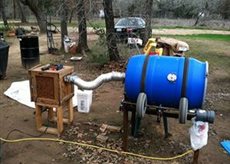What is the Wave
In physics, a wave is an oscillation accompanied by a transfer of energy that travels through a medium (space or mass). Frequency refers to the addition of time. Wave motion transfers energy from one point to another, which displace particles of the transmission medium–that is, with little or no associated mass transport. Waves consist, instead, of oscillations or vibrations (of a physical quantity), around almost fixed locations.
There are two main types of waves. Mechanical waves propagate through a medium, and the substance of this medium is deformed. Restoring forces then reverse the deformation. For example, sound waves propagate via air molecules colliding with their neighbors. When the molecules collide, they also bounce away from each other (a restoring force). This keeps the molecules from continuing to travel in the direction of the wave.
The second main type, electromagnetic waves, do not require a medium. Instead, they consist of periodic oscillations of electrical and magnetic fields originally generated by charged particles, and can therefore travel through a vacuum. These types vary in wavelength, and include radio waves, microwaves, infrared radiation, visible light, ultraviolet radiation, X-rays and gamma rays.
Waves are described by a wave equation which sets out how the disturbance proceeds over time. The mathematical form of this equation varies depending on the type of wave. Further, the behavior of particles in quantum mechanics are described by waves. In addition, gravitational waves also travel through space, which are a result of a vibration or movement in gravitational fields.
A wave can be transverse, where a disturbance creates oscillations that are perpendicular to the propagation of energy transfer, or longitudinal: the oscillations are parallel to the direction of energy propagation. While mechanical waves can be both transverse and longitudinal, all electromagnetic waves are transverse in free space.
Solar winds at over 2.5 Million Miles per Hour Strike our Planet.
VIA : thetimenow.com
What is the solar wind?
The solar wind is the term used to describe the endless stream of particles like electrons and protons that the sun constantly emits. The solar wind consists of plasma from the Sun’s corona. The solar wind is visible when the light of the Sun is blocked, such as during an eclipse.

Coronal mass ejections of the Sun. © Courtesy of SOHO/LASCO consortium
The solar wind can reach speeds of 900 kilometers per hour. Its speed varies based on the Sun’s magnetic field while the volume of particles peaks with large flares. The solar wind is greatest above coronal holes, where the Sun’s magnetic field is weak and more particles can escape into space. The solar wind‘s strength and speed are less intense over streamers. Solar wind strength varies over the Sun’s 27 day rotation. The speed and strength of the solar wind peaks when the Sun generates Coronal Mass Ejections. When the Sun is at its Solar Maximum, a time in the sunspot cycle when solar output peaks, the solar wind increases. This cycle averages eleven years.
What are the effects of the solar wind on Earth?

Aurora Borealis. © No known credit
One of the most dramatic effects of the solar wind on Earth is the Aurora Borealis. The solar wind strikes the Magellan Belt, the protective magnetic field around the Earth. The variations in radiation and magnetism on the charged particles cause the waves of light that dance at the northern and southern poles. Solar flares and an increased solar wind increase radiation levels that interfere with satellites in Earth’s orbit. Severe solar flares can even interfere with electronics and cell phone communication on Earth. In 1989, a solar storm disrupted electrical power lines and telecommunications across Earth. As the proliferation of wireless technology grows the impact of solar flares and peaks in the solar wind only increase.
There is currently debate as to the impact of the solar wind on Earth’s temperature. The Sun generates the heat that keeps Earth warm and livable. When solar output increases, the Earth grows warmer. Sun spots and the solar wind are both byproducts of the Sun’s internal processes. While a greater solar wind does not mean that the Earth will get hotter, increased activity in the Sun that makes it hotter will warm the Earth while increasing the solar wind’s speed and density.
How does the solar wind affect other planets and bodies?
The solar wind is the force that causes comets to have tails that point away from the Sun. The solar wind is also the force that carries away molecular hydrogen when water and hydrocarbons are broken up by the Sun’s UV rays. The loss of Mars‘ magnetic field allowed the solar wind to carry molecular hydrogen into space as UV broke down water vapor in its atmosphere. This is why Mars has no water and little water vapor but abundant oxygen isotopes to bind with its iron rock surface. The solar wind took away the hydrogen while the free oxygen bound with the rock because that was all that was left behind.

The heliosphere is made up of charged particles. © NASA/Feimer
The solar wind is what creates the heliosphere. The heliosphere is made up of charged particles thrown out by the solar wind in all directions. The solar wind slows down at a boundary called the termination shock. At this point, its speed drops dramatically from the hundreds of miles per hour at which it was ejected from the Sun. At the heliosheath, it slows even further. At the heliopause, the solar wind slows and essentially stops. Just as the boundary between Earth and space is marked by when the atmosphere fades to vacuum, the edge of the heliosphere is one marker for the edge of our solar system. The heliopause is one way of determining where the solar system ends and interstellar space begins.
Studying the solar wind

Sun’s streamers of super-hot, electrically charged gas. © NASA/IMAGE ASSET MANAGEMEN
The Helios probes were launched in the mid-1970s and entered orbit around the Sun to study it. Both probes were a joint effort by American and West German scientists. The Advanced Composition Explorer or ACE is a satellite launched in 1997. It was located at Lagrange Point 1, an orbital point where the pull of the Sun and the Earth are equal. This means that it will remain in that orbit until it fails. The ACE satellite monitors the solar wind and sends this data back to NASA. You can view data from ACE on the National Oceanic and Atmospheric Administration or NOAA space weather website.
The Ulysses spacecraft orbited the Sun twice. The Ulysses measured the solar wind, the Sun’s magnetic field and molecular composition. It was retired in 2009.

An artists depiction of the RHESSI spacecraft observing the sun. © NASA/Goddard Space Flight Center
There has been an ongoing stream of spacecraft sent by NASA to study the Sun. RHESSI, launched in 2002, is a satellite carrying a solar spectroscopic imager. It was sent to study the energy release that accompanies solar flares and the particle acceleration patterns in the accompanying solar wind. The Cosmic Hot Interstellar Plasma Spectrometer or CHIPSfor short was launched in 2003. The Interstellar Boundary Explorer or IBEX was launched by NASA in 2008 specifically to mark the boundary between the Solar System and interstellar space.
It discovered that the solar wind does not generate a bow shock as it slows down from supersonic speeds.
A craft called the Solar Dynamics Observatory or SDO was launched in 2010. It is measuring the variability of the Sun, including the solar wind. CINDI is short for Coupled Ion Neutral Dynamic Investigation. This space satellite studies the impact of space weather, including the solar wind, on Earth’s atmosphere.
The SOHO spacecraft is a solar observatory. While it focuses on the Sun, it has also discovered over a thousand comets. ARTEMIS was launched in 2007. It studies the impact of the Moon and Earth on the solar wind. ARTEMIS was originally part of the THEMIS mission to study the Earth’s magnetic field and the aurora borealis.
Solar Probe Plus will be into the Sun’s corona to answer questions as to why the solar corona or gaseous layers are hotter than the photosphere, its surface. It is tentatively scheduled for launch in 2015. The American space agency is not the only organization studying the Sun. The solar satellite Hinode was launched by Japan. Its name translates into English as “sunrise”. Japan also collaborated with NASA to build the GEOTAIL satellite to study the Earth’s magnetic tail.
Survival Food Prepping Ideas/ULTIMATE Top Skills 2017
Discover how to survive: Most complete survival tactics, tips, skills and ideas like how to make pemmican, snow shoes, knives, soap, beer, smoke houses, bullets, survival bread, water wheels, herbal poultices, Indian round houses, root cellars, primitive navigation, and much more at: The Lost Ways
The Lost Ways is a far-reaching book with chapters ranging from simple things like making tasty bark-bread-like people did when there was no food-to building a traditional backyard smokehouse… and many, many, many more!
The Lost Ways is a far-reaching book with chapters ranging from simple things like making tasty bark-bread-like people did when there was no food-to building a traditional backyard smokehouse… and many, many, many more!
Books can be your best pre-collapse investment.
The Lost Ways (Learn the long forgotten secrets that helped our forefathers survive  famines,wars,economic crisis and anything else life threw at them)
famines,wars,economic crisis and anything else life threw at them)
Survival MD (Best Post Collapse First Aid Survival Guide Ever)
Conquering the coming collapse (Financial advice and preparedness )
Liberty Generator (Build and make your own energy source)
Backyard Liberty (Easy and cheap DIY Aquaponic system to grow your organic and living food bank)
Bullet Proof Home (A Prepper’s Guide in Safeguarding a Home )
Family Self Defense (Best Self Defense Strategies For You And Your Family)
Survive Any Crisis (Best Items To Hoard For A Long Term Crisis)
Survive The End Days (Biggest Cover Up Of Our President)
Drought USA (Discover The Amazing Device That Turns Air Into Water)


